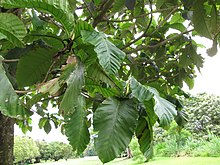| Artocarpus sericicarpus | |
|---|---|

| |
| Conservation status | |
 Least Concern (IUCN 3.1) | |
| Scientific classification | |
| Kingdom: | Plantae |
| Clade: | Tracheophytes |
| Clade: | Angiosperms |
| Clade: | Eudicots |
| Clade: | Rosids |
| Order: | Rosales |
| Family: | Moraceae |
| Genus: | Artocarpus |
| Species: | A. sericicarpus |
| Binomial name | |
| Artocarpus sericicarpus F.M.Jarrett | |
Artocarpus sericarpus, the peluntan, pedalai, gumihan or terap bulu, is a tropical evergreen tree species of the family Moraceae. It is the cousin of jackfruit and breadfruit.
The tree is native to Borneo, the Philippines, the Maluku Islands and Sulawesi, and is most commonly found in humid tropics with a mild monsoon climate, occurring in tropical evergreen forests at 500–1,000 metres (1,600–3,300 ft) elevation. It is also occasionally found in steep, clayey hillsides of inland areas. The discovery date is not clear as it is listed as 1959 in one book and 1961 in the other.
It is a very large rainforest tree to 40 m (120 ft). Similar to the marang fruit (Artocarpus odoratissimus), the pulp of the fruit is edible and considered very tasty but A. sericicarpus does not have strong odor of the marang. The seeds are also edible, people normally boil or roast them and consume them like peanuts. Artocarpus sericicarpus measures up to 30–40 m (100–130 ft), stipule are lanceolate and measure at 6–12 centimetres (2–5 in) and its dark green leaves are elliptic and ovate and measure at 20–70 cm (8–28 in) by 10–50 cm (4–20 in). The tree's bark is also used to make barkcloth.
The fruit is hairy, and looks like a giant rambutan. When the globular fruits (15 cm (6 in) diameter) are ripe, the skins are bright orange, covered with hair. The pulp is white in color and tastes very sweet. Some say the Pedal fruit is the tastiest of all Artocarpus.
References
- Botanic Gardens Conservation International (BGCI).; IUCN SSC Global Tree Specialist Group. (2018). "Artocarpus sericicarpus". IUCN Red List of Threatened Species. 2018: e.T86533348A135759310. doi:10.2305/IUCN.UK.2018-2.RLTS.T86533348A135759310.en.
- Janick, Jules; Paull, Robert E. (2008). The Encyclopedia of Fruit and Nuts. CABI. p. 482. ISBN 978-0851996387. Retrieved September 14, 2015.
- ^ Verheji, E. W. H., Coronel, Robert E., Edible fruits and nuts, page 80, 1991, Pudoc Press, ISBN 9022009866
- The Malayan Forester, page 262, 1969
- ^ Lim, T. K. (2012). Edible Medicinal And Non Medicinal Plants: Volume 3, Fruits. Springer Publishing. p. 351. ISBN 978-9400725331. Retrieved September 14, 2015.
- Hanelt, Peter (2001). Mansfeld's Encyclopedia of Agricultural and Horticultural Crops: (Except Ornamentals). Springer Publishing. p. 361. ISBN 3540410171. Retrieved September 14, 2015.
| Taxon identifiers | |
|---|---|
| Artocarpus sericicarpus |
|